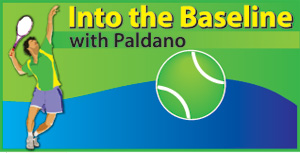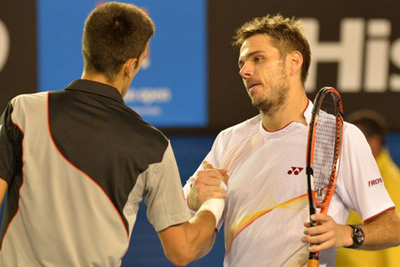Choice-cuts of Paris Tennis
Last week’s French championships promised and delivered the choice cuts of Tennis beyond all expectations. It proved why it is one of the ‘majors’ of the world in competitive Tennis. The event marveled the Tennis world with their organizational finesse, presentation, ambiance and the venue. It reached new heights in facilitating players, spectators and the worldwide audience through audio, visual, electronic and print media in the most appealing manner to be remembered for years to come.
 French classic
French classic
The two main functions of any good national Tennis association are to conduct effective and appealing events; and to sustain the popularity of the game and participation in the country among its people. The French have excelled in both, for over one hunded years. To sustain something for this long and to improve it each year, says a lot about the strength and character of the organization. They conducted the main five open-events of the championships which are the two singles, two doubles and the mixed doubles, extremely well.
The players’ who managed to be in the draw knew what was at stake – a permanent place in world Tennis history. All five draws produced matches of great interest for two full weeks. Live performances had high rating with packed stadium at Roland-Garros. Media took the event worldwide to be shown at prime times and to be read in all four corners of the world. In short, the Tennis world did stop to watch the French-Open.

Switzerland’s Stanislas Wawrinka after beating Serbia’s Novak Djokovic
The main actors in a sporting event are the sportsmen. French-Open as in the all majors is very selective as to who they allow to get onto those courts to perform. The draw controls this aspect. The French Association, made sure their venue ‘Roland-Garros’ featured the best of the world ranking. The singles events had a cut off around 150th position in the ranking for the qualification rounds, of that only 128 were allowed to play in the main draw. This provided the best clay court Tennis for two weeks flavoured with Parisian glamour. It fact it is ‘France’ they present and not just Tennis alone.
Singles challenge
The two open singles events started with the qualification rounds which made the singles draws to have good matches from the very first rounds. Of the 8 top seeded players many did not reach the berth that was reserved for them in the quarter finals. So fierce was the challenge even up to the quarter finals.
If one has to select the best matches of the women’s draw, it will not be only the finals. Some matches will linger on in our minds for the competitiveness and good Tennis it produced. In Czech Republic’s Safarova a star was born and provided a firm challenge until the final stroke of the third set to Serena Williams for her third title. Belarus’s Victoria Azerenka staging a comeback played a great match against Serena Williams in the early rounds. France’s Alize Cornet played three ‘gutty’ matches until fatigue overtook her. With her manner and style, she also became a ‘darling’ to the French audience. Her French flair for life, Cornet has been the ‘missing-link’ in French Sport – somewhat like Suzanne Lenglen, the multiple French-Open title winner of the 1920s and today one of the Roland Garros Stadium courts is named the ‘Suzanne Lenglen court’. Alize Cornet had a great tournament and she is certainly another ‘rising star’ of the game.
The other women players who left unforgettable impressions are Czech Republic’s Petra Kvitova, Serbia’s Ana Ivanovic, Venezuelan born Spain’s Garbine Mugurusa, Italy’s Sara Errani, Switzerland’s Timea Bacsinsky, Belgian Alison van Uytvanck and the first Ukrainian in any Grand-Slam quarter finals Elina Svitolina. They were all seen in the final three rounds contributing memorable moments to the event. The rest of the year will echo these names for sure.
The men’s rounds
From the 4th round, men’s matches turned out to be very hard and produced some captivating clay court Tennis. Four Frenchmen came through and provided the ‘French flair’ to the men’s side – Plucky Richard Gasquet, elegant stroke maker Georges Simon, ‘funny boy’ and one of the fastest on court Gael Monfils and the only Frenchman in the semi finals, Jo Wilfred Tsonga produced roars of applause from the stadium with brilliant winning streaks. Tsonga beat Japan’s Kei Nishikori to reach the semi finals but he could not withstand the pace and volume of Switzerland’s Stanislas Wawrinka. Wawrinka with his Swedish coach Magnus Norman, a former world’s top ten, has come out of the ‘lean period’ he has been experiencing since he won the Australian-Open few years back.
Djokovic’s career grand-slam denied
In the finals between Serbia’s Novak Djokovic and Wawrinka, all seem to be over when Djokovic won the first set convincingly and looked set for the ‘career grand slam’. Things changed very quickly, it was Wawrinka who opened up the game, winning the next three sets in an epic performance where the two did not spare weaponry to attack and destroy each other’s initiatives. In the fourth set Wawrinka lost his own serve in the very early stages then broke Djokovic twice to wrap up the match taking the French-Open title and two million dollars home to Lausanne.
In engaging the opponent to wrestle an opening, the two finalists had 24 shot rallies at average speeds of over 120 Kmph. The ground stroke winners reached sizzling 170Kmph. The match lasted over three hours leaving both exhausted. Djokovic remains as a great player yet to win the French-Open. Losing it to Wawrinka means he cannot go for the career Grand-Slam this year and will have to wait to fulfill this dream. In the fourth set Djokovic was tired. He had the disadvantage of having to play three successive days as his semi-finals match against Briton’s Andy Murray was completed only the previous day. For this reason or may be due to the exhaustion of the two week event, Djokovic did not look fresh in the latter part of the finals. Wawrinka had a rest day before the match. This may have produced the winning edge but Wawrinka did produce some unbelievable Tennis to clinch the title.
Doubles
Doubles attracted more spectators than usual because the clay court’s slow speed, making the rallies longer and spectators enjoyable. The Men’s final’s created an upset when much fancied, world dominating Bryan brothers, Mike and Bob lost to Croatia’s Ivan Dodig and Brazil’s Marcelo Melo in three sets. If anyone out there is interested in good doubles, watch this video. It had every ingredient that makes doubles exciting. The Bryan brothers have dedicated their lives to play doubles and a lot of their court behaviour has become the norm in doubles, especially between points. The Bryan’s remain alive between points and run to take position and not walk. The twins did not have much opposition for a long time. It is not the case now and in the French-Open their loss is proof of the turnaround in double’s interest. Bryan brothers, like the two Woodies of Australia, have contributed to sustain doubles in major events in the lean period of its popularity.
Bethanie Mattek-Safarova double
Women’s double winners were singles finalist Lucie Safarova and USA’s Bethanie Mattek-Sands, both seeded and ranked 7 in doubles, showed their intention clearly when they beat number one pair Switzerland’s Martina Hingis and India’s Sanya Mirza in the quarter-finals. It was not easy. To win the title their last three round matches went to three sets. The all court game of the women’s doubles in contrast to the base line dominated play of singles was very dynamic and the spectators loved it.
In Mixed doubles, Bethanie and right-handed Mike Bryan made a short work of their finals beating Czech Republic’s Lucie Hradecka and Poland’s Marcin Matkowski. This year the French-Open featured two players in two finals – Czech Republic’s Lucie Safarova, runner up in the women’s singles and winner of the women’s doubles partnering USA’s thirty year old Bethanie Mattek-Sands. And Bethanie who also won the mixed doubles was the only one to take home two titles.
The sizzling and sensation 2015 French-Open is over for this year but not the European season. Next is the European grass court season and the ‘big apple’ of it is the Wimbledon title, which is the All England Tennis championship’s starting in the last week of June. Until then there are a few warm up grass events in England and in Continental Europe.
George Paldano, former international player; Accredited Coach of Germany,
National coach, Davis Cup and Federation Cup Coach; ITF and USPTR;
–gptennis.ceylon@gmail.com-


